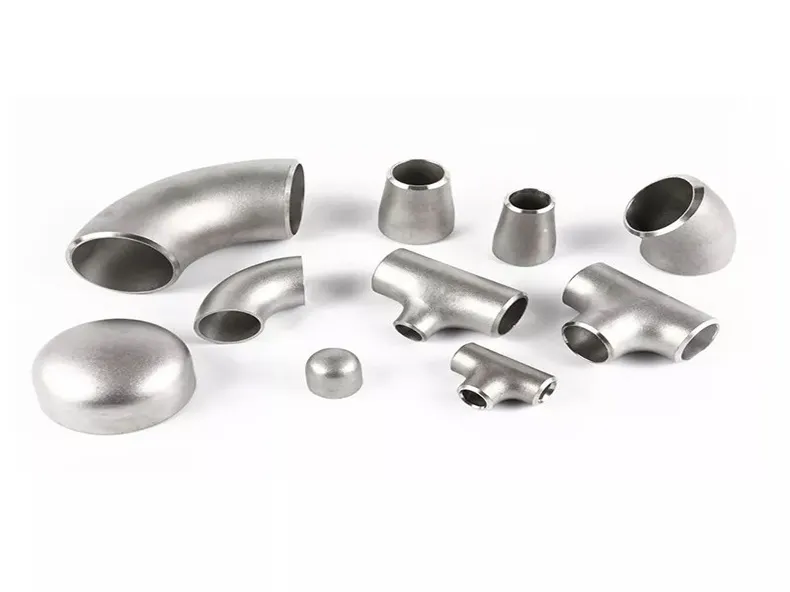Stainless Steel Pipe Fittings
Stainless steel pipe fittings are crucial components in plumbing and piping systems, offering exceptional corrosion resistance, durability, and versatility. Available in various shapes, sizes, and configurations, these fittings enable secure connections between stainless steel pipes, facilitating fluid conveyance in a wide range of applications. Whether it’s elbows for directional changes, tees for branching connections, couplings for joining pipes, or caps for sealing ends, stainless steel fittings provide reliable solutions for diverse plumbing needs. If you are interested in our stainless steel pipe fittings, please contact us.
REFINE BY
- Flange Manufacturer
- Flange standard
- Welding Neck Flange
- Stainless steel Flange
- Carbon & Alloy steel Flange
- Blind Flange
- Lap Joint Flange
- Orifice Flange
- Threaded Flange
- Swivel Ring Flange
- Reducing Flange
- Slip-On Flange
- Spectacle Blind Flange
- Compact Flange
- 1/2" (24)
- 3/4" (24)
- 1" (24)
- 1-1/4" (24)
- 1-1/2" (24)
- 2" (25)
- 2-1/2" (24)
- 3" (24)
- 4" (20)
- 4" (20)
- 304L (179)
- 316L (179)
Stainless Steel Pipe Fittings Models
Material Grades Of Stainless Steel Pipe Fittings
This grade is the most widely used austenitic stainless steel, known for its excellent corrosion resistance, formability, and weldability. It is appropriate for a broad array of applications, including plumbing, food processing, and architectural components.
Grade 316 stainless steel contains molybdenum, which enhances its corrosion resistance, particularly in chloride environments. It is commonly used in marine, chemical processing, and pharmaceutical industries where superior corrosion resistance is required.
Similar to 316 stainless steel, 316L is a low-carbon variant with improved weldability and corrosion resistance, making it ideal for applications requiring extensive welding or exposure to corrosive environments.
Grade 317 stainless steel contains higher levels of molybdenum and chromium than 316 stainless steel, providing enhanced resistance to corrosion and pitting in acidic environments. It is commonly used in chemical and petrochemical processing industries.
Grade 321 stainless steel contains titanium, which stabilizes the material against chromium carbide precipitation during welding, reducing the risk of intergranular corrosion. It is often used in high-temperature applications such as exhaust systems and furnace parts.

Stainless Pipe Fittings Applications
Plumbing And Water Systems
Stainless steel pipe fittings are extensively utilized in plumbing systems for residential, commercial, and industrial purposes. They are suitable for conveying potable water, wastewater, and other fluids due to their corrosion resistance and hygienic properties.
Chemical Processing
Stainless steel fittings are used extensively in chemical processing industries where resistance to corrosive chemicals and high temperatures is critical. They are employed in pipelines, reactors, storage tanks, and other equipment for handling acids, alkalis, solvents, and corrosive gases.
Oil And Gas
Stainless steel pipe fittings are utilized in oil and gas exploration, production, refining, and transportation facilities. They are resistant to corrosion from crude oil, natural gas, and various petroleum products, making them ideal for offshore platforms, refineries, pipelines, and storage tanks.
SS Pipe Fittings Installation
- For threaded fittings, apply a suitable thread sealant or tape to the male threads before assembly. To prevent damage to the threads or connectors, refrain from over-tightening;
- For socket weld fittings, insert the pipe into the socket and ensure proper alignment. Tack weld the joint to hold the pipe in place, then complete the weld around the entire circumference;
- For butt weld fittings, ensure proper alignment and fit-up of the pipes before welding. Use the appropriate welding technique and filler material according to the specifications of the stainless steel grade being used;
- For flanged fittings, ensure that the flange faces are clean and flat before assembly. Use gaskets and bolts of the appropriate material and size, and tighten the bolts evenly to ensure a proper seal;
- Properly support the pipes and fittings to prevent stress and distortion during installation. Use hangers, supports, and guides as necessary to maintain alignment and prevent sagging or movement;
- After installation, perform a pressure test on the piping system to ensure there are no leaks or defects. Use a suitable test medium and follow industry standards and regulations for pressure testing procedures;
- Inspect the installed fittings for any signs of damage, leaks, or inadequate weld penetration. Address any issues promptly to ensure the integrity and reliability of the piping system.
SS Fittings Surface Finish
Stainless steel fittings undergo various surface finishing processes to enhance their appearance, durability, and corrosion resistance. One common finishing technique is shot blasting, where high-velocity abrasive particles are propelled onto the surface of the fitting, removing surface contaminants, scales, and oxides. This results in a uniform matte finish that improves cleanliness and provides a suitable surface for subsequent coatings or treatments.
Additionally, pickling and passivation processes are employed to remove impurities and oxides from the surface of the stainless steel fitting, leaving behind a clean, corrosion-resistant surface. Pickling involves the use of acidic solutions to dissolve surface contaminants, while passivation promotes the formation of a protective oxide layer that enhances the fitting’s resistance to corrosion. Another surface finishing option is electropolishing, an electrochemical process that removes surface imperfections and microburrs, leaving behind a smooth, bright finish with improved corrosion resistance and cleanability. Electropolished surfaces are commonly used in sanitary applications where cleanliness and hygiene are critical, such as in pharmaceutical, food processing, and biotechnology industries.
Additionally, plating or coating processes may be employed to further enhance the surface properties of forged stainless steel fittings. Chrome plating can provide improved corrosion resistance and a decorative finish, while coatings such as PTFE or epoxy can offer additional protection against corrosion and chemical attack. The choice of surface finish depends on factors such as the application requirements, environmental conditions, and desired aesthetics, ensuring that forged stainless steel fittings fulfill the particular requirements of diverse industries while maintaining long-term performance and durability.
Stainless Steel Plumbing Fittings Cost Considerations
Stainless steel is typically more costly than other materials commonly used for plumbing fittings, such as brass. The cost of stainless steel fittings will rely on factors like the stainless steel grade, the manufacturing process, and market fluctuations in raw material prices.
While stainless steel fittings may have a higher upfront cost, they offer excellent durability and corrosion resistance, resulting in lower long-term maintenance and replacement costs. Investing in high-quality stainless steel fittings can reduce the risk of leaks, corrosion, and premature failure, leading to cost savings over the lifespan of the plumbing system.
The installation of stainless steel fittings may require specialized tools, equipment, and expertise, which can impact installation costs compared to other materials that are easier to work with. However, stainless steel fittings typically offer superior performance and reliability, potentially reducing the need for costly repairs or replacements down the line.
Stainless steel fittings may be more compatible with certain types of piping materials, such as stainless steel pipes or other metals, compared to non-metallic materials. Consideration should be given to compatibility issues, as utilizing incompatible materials can result in corrosion, leaks, and system malfunctions, resulting in additional costs for repairs or replacements.
Stainless steel fittings are environmentally friendly and recyclable, contributing to sustainability efforts and potentially reducing disposal costs compared to non-recyclable materials. Additionally, the long lifespan of stainless steel fittings lessens the necessity for frequent replacements, thereby decreasing waste and associated costs.
Stainless Steel Pipes And Fittings Manufacturer
Product Range And Diversity
Elite Piping offers a comprehensive range of stainless steel pipe fittings to suit various industrial, commercial, and residential applications. Our product line includes, but is not restricted to elbows, tees, reducers, couplings, unions, caps, crosses, plugs, and flanges. These fittings come in various sizes, dimensions, grades, and configurations to accommodate the varied requirements and specifications of customers across different industries.
High-Quality Materials And Manufacturing Processes
Elite Piping utilizes only the finest quality stainless steel materials sourced from reputable suppliers to ensure the superior performance and durability of their fittings. The company employs advanced manufacturing processes, including forging, machining, heat treatment, and precision finishing, to produce fittings that meet or exceed industry standards and customer expectations. Stringent quality control measures are enforced at every phase of the production process to uphold uniform quality and reliability.
Industry Applications And Market Presence
Elite Piping’s stainless steel pipe fittings find applications across a wide range of industries, including oil and gas, petrochemical, chemical processing, power generation, water treatment, pharmaceuticals, food and beverage, marine, and construction. The company serves customers globally, with a strong presence in key markets such as North America, Europe, Asia Pacific, and the Middle East. Elite Piping’s fittings are trusted by leading companies and contractors for critical applications where reliability, performance, and safety are paramount.
Commitment To Quality And Customer Satisfaction
At Elite Piping, quality is not just a goal but a commitment. The company follows rigorous quality management systems and standards, including ISO 9001 certification, to ensure that every fitting meets the highest quality and performance standards. Elite Piping’s dedication to quality extends to customer service, with a team of skilled and attentive professionals who provide expert technical support, prompt assistance, and personalized solutions to meet customer needs.
Sustainability And Environmental Responsibility
Elite Piping is committed to sustainability and environmental responsibility in all aspects of our operations. The company employs eco-friendly manufacturing processes, implements energy-saving measures, and promotes recycling and waste reduction initiatives to minimize our environmental footprint. Elite Piping’s stainless steel fittings are inherently sustainable, as stainless steel is 100% recyclable and can be reused indefinitely without degradation, making us an environmentally friendly choice for piping applications.
Elite Piping Manufacture Co., Ltd. stands out as a leading manufacturer and supplier of stainless steel pipe fittings, offering a comprehensive range of high-quality products, customized solutions, and exceptional service to customers worldwide. With a strong commitment to quality, precision engineering, and customer satisfaction, Elite Piping is the preferred choice for reliable, durable, and cost-effective fittings for a broad spectrum of industrial and commercial uses.
GET IN TOUCH
Company:
bazhou elite s
d manufacture co.,ltd.
Factory Address:
Office # 805, Building No. 6 Poly Metropolitan, Yongshum Town, Tongzhou District, Beijing, China.
Contact Person:
Thomas
Contact Numbers:
+86 88888888888
Email:
sales@ematal.com







